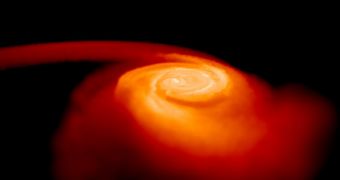Astrophysicists say that collisions between neutron stars can generate shock waves so powerful that they send radio signals throughout their surroundings. These emissions could theoretically be used to verify if the gravity waves Albert Einstein's theory imply to exist are real or not.
Thus far, the cosmic distortions have proven very elusive, as investigators were unable to capture even a fleeting glimpse of gravity waves. The massive amount of energy produced during a neutron star collision could have significant-enough effects on spacetime to reveal these constructs.
A neutron star is the collapsed core of a massive star that exploded as a supernova, without having sufficient initial mass to implode into a black hole. Simply put, these neutron stars weigh about as much as the entire Sun, but their matter is packed in a globe just 20 miles (32 kilometers) in diameter.
What this means is that they are unbelievably dense, with matter at their core existing in states that theoretical physicists are only now beginning to comprehend. Space reports that a collision between such bodies would result in the release of nearly-immeasurable amounts of energy.
Radio particles accompanying the emissions could travel between 10 percent and 50 percent the speed of light. “The explosion accelerates electrons to a very high energy. The electrons produce mostly radio emissions, which creates a quasi-spherical blast wave,” Hebrew University astronomer Tsvi Piran says.
“Binary collisions are very rare. But they are very important because they are the best sources of gravitational radiation,” adds the scientist, who was the leader of the team that conducted the study.
Gravity waves – as hypothesized by Albert Einstein's theories – are distortions, ripples in spacetime that are produced when the foundation itself shifts. Only magnificent events such as black hole mergers and neutron star collisions can cause such impressive distortions.
Working together with colleague Ehud Nakar at the Tel Aviv University, also in Israel, Piran was able to set the foundation for studies that will only be conducted after the next generation of telescopes is constructed. By that time, the theoretical background will be set in place.
Details of the new investigation are published in the September 28 online issue of the top scientific journal Nature. By searching for neutron star collisions, the team reports, it may be possible to establish just how often gravity waves are produced in the nearby Universe.
Already, several instances of cosmic collisions are suspected of having involved neutron stars, but astronomers have no way of knowing for sure whether this is true or not. As such, they now have to wait for the next cataclysmic impact to occur.

 14 DAY TRIAL //
14 DAY TRIAL //